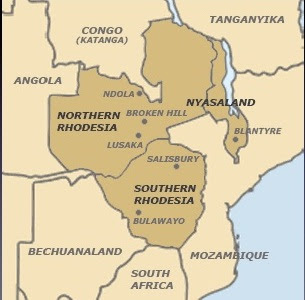The Effects of Social Reforms on Land Usage in Zimbabwe
Introduction:
Zimbabwe, known mostly for its economic disaster in 2007 with hyperinflation reaching tens of trillions, is an interesting piece of the greater picture of countries in Sub-Saharan Africa that have taken reparation measures in their postcolonial existences. Like many other Sub-Saharan African countries, there exists a rather large white European population in Zimbabwe that to this day still holds some contention with the native black African one. Although things have cooled down since the early 2000s, land reform and redistribution has contributed a lot to Zimbabwe's infrastructure and overall economic productivity. In this blog post, I will unpack key social and political reforms and policies that have shaped modern day water and development issues for the country through a historical and political lens.
Rhodesia and British Colonization:
Zimbabwe, before it became its own nation, was ruled by the British South Africa Company until 1922 where a white minority in Zimbabwe (Rhodesia) came into power. British style of colonization often included a significant amount of white settlers to the region to establish power and rule, so it was a natural procession for that white group of settlers to take over after official company power left. Although it was still technically under the Crown, this white minority had power to shape politics and various acts such as the Land Apportionment Act in 1930 which restricted black African land ownership and use.
(BBC 2019). This is the beginning of a long and bitter conflict between black Zimbabweans and white settlers. Black farmers were forced into Communal Area Zones which eventually became the bases for guerilla warfare and rebellion later.
(Cliffe et al 2011). Zimbabwe (former Southern Rhodesia) along with Zambia (Northern Rhodesia) and Malawi (Nyasaland) together formed the Central African Federation, however Zambia and Malawi each gained independence in 1963 leaving Rhodesia still under British rule.
During its time in the CAF, two major parties ZAPU (Zimbabwe African People's Union) and ZANU (Zimbabwe African National Union) began to heavily resist white rule in the country. Robert Mugabe, of ZANU became an icon for a return to black African rule to the region and was heavily supported by allies in Zambia, Mozambique, and Malawi. Ian Smith, a white prime minister attempted to create a state with white minority rule, however, years of guerilla warfare and international scrutiny squashed the idea of a Zimbabwe-Rhodesia state.
(BBC 2019). Robert Mugabe then becomes President of Zimbabwe, which finally gained its independence in 1980 and sacked the ZAPU opposition. Until very recently (2017), Robert Mugabe ruled Zimbabwe with many allegations of fraud, corruption, and undemocratic practices.
 |
| Wood 1983 |
Mugabe's Land Reform:
Now that we have discussed Zimbabwe's past with colonialism and white rule, we can now look at the drastic land reform measures Mugabe's administration took to correct colonial imbalance. In the early 2000s, violent land seizures took place, causing many white farmers to flee to neighboring South Africa and leaving remaining white Zimbabweans jobless and homeless.
(Mukeredzi 2019). Mugabe's Land Acquisition Act in 2000 was a direct retaliation to the previous Land Apportionment Act that was established under British Rule. This allowed for land seizures without notice or compensation and directly targeted at white farmers. Vocabulary such as "occupations", "invasions", and "incursions" used to describe white owned farms really sets the tone of how the 2000 land seizures came to be
(Cliffe et al 2011). The want and desire to reclaim what was once theirs (black African) ruled Mugabe's long administration. The Fast Track Land Reform's aim to dismantle white commercial farming was extremely race motivated with little to no concern for economic implications.
(Chiweshe 2018).
Now What? Looking Towards the Future:
Today there is little privately owned land left in Zimbabwe. Most land is government controlled and sanctioned. However, under the new Zimbabwean President Emmerson Mnangagwa, new land reform policies are finally allowing white farmers back because ability, not skin color, now dictates who can farm the land.
(Sihlobo 2019). Historically, crop yields dropped dramatically in the early 2000s due to black farmers taking over crops and land they did not have a lot of knowledge about. However under Mnanagawa's Command Agriculture program, in 2017, maize crops were the highest they have been since Mugabe's reforms.
(Sihlobo 2019). It is extremely important for Zimbabwe to invest in these sorts of programs because although the country has been industrializing, the country still relies heavily on its agricultural production.
(Moyo 2011). However, many say that these reforms are not enough. Although it has done a bit to heal racial wounds within the country, the government control of the land still persists and does not allow for the potential yields and benefits the land could be producing with the allowance of wide scale commercial farming.
(Mukeredzi 2019). Mukeredzi also notes in his article how the racial cooperation may actually just be a ploy to gain international support and funding to help the country recover from Mugabe's reign. Either way, Zimbabwe still has a long way to go, both in recovery socially between whites and blacks but also in it's control of land usage and distribution.





Comments
Post a Comment